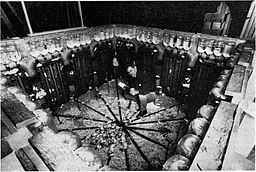We keep tinkering with our world, trying to make it better, more comfortable to live in. How we work, communicate, have fun and even the way we grow our food are constantly evolving. We are trying to create a utopia, but Dr. John Calhoun’s 1973 study suggests we might be in for a not-so-happy ending.
After the Second World War, population started rising frighteningly quickly, and it became obvious that such growth can’t go on forever. So, where does it stop? What will happen when it does?
Worries about overpopulation stimulated studies about the effect population density has on individual’s behaviour and perhaps the most famous was Dr. Calhoun’s mouse study, explained in the video below.

Youtube video courtesy of: tamerahunt.
Mice were put in an environment where they faced no predation or scarcity of food or water. The only limiting factor was the space, which could still support around 3000 mice. But the population never come close to that number.
To begin the study, 4 pairs of breeding mice were introduced to their new environment (called Universe 1) and after an initial period of about three months, the population started rising exponentially. By day 315, there were already 620 mice. This is still far from the predicted 3000, but the growth stopped there. The animals were becoming increasingly aggressive and anti-social.
By day 600, society broke. The young were expelled before reaching maturity and were attacked by dominant males. Females also became more aggressive while non-dominant males became passive. Rather than reproduce, the mice started attacking each other. This escalated to the point where there were no new births, or if there were, the females would kill their own pups. Mortality rose dramatically.
One might think that once the population fell below some threshold, the behaviour might normalize, but it didn’t. The change that occurred in mice was irreversible and they were heading for doom. Dr. Calhoun called the tipping point the “Behavioral Sink”.
In this sick society, a subgroup emerged that seemed almost a separate species and Dr. Calhoun called them the “Beautiful Ones”. They were kept secluded from birth and were spared the insanity at the cost of no social interactions. They were hermits of sorts but because they lacked social interactions, they were also less intelligent. They weren’t violent, but they didn’t procreate either.
In the end, the colony died off. The research team made 25 such “Universes” and got the same result every time.
These were studies on mice, but parallels can be made with our own species. In the developed world, countries are facing negative natural growth. In Europe for example, an average couple only has 1.4 children. If it weren’t for immigration, the population would already be in irreversible decline. Random violence? The shootings at schools don’t even shock us anymore. Mothers killing their young? Just last week, there was a pro-life demonstration on campus, I’m sure they’d love to tell you all about that.
Maybe these examples seem contrived, but perhaps there is something to it. Perhaps, it would be best if we all went live in the woods and be merry. 🙂
Jan

